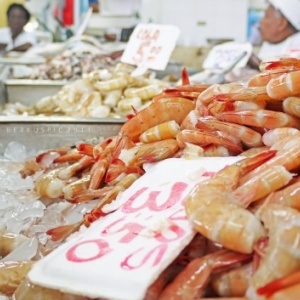
This new paper in Marine Policy suggests that eco-label improvements can be made by integrating the carbon footprints of products in sustainability assessments (eco-labels, sustainability certification, or consumer seafood sustainability guides).
Although sustainability “eco-labels” are now widespread in the seafood industry and many products are labelled “environmentally-friendly”, many types of seafood have very high carbon footprints. This paper argues that integrating carbon footprints into existing and future seafood awareness campaigns would create more holistic measures by which the environmental impact of fisheries products can be assessed by consumers, retail businesses and producers. This paper discusses next steps towards incorporating carbon footprints into seafood eco-labels and describes how emerging technologies and tools, such as the recently launched Global Fishing Watch will increasingly facilitate accurate calculation of specific seafood sectors׳ – and even potentially individual vessels׳ – carbon footprints.
Issues that need to be dealt with in order to successfully implement an integrated label include: agreeing upon a standard methodology for calculating carbon footprints (e.g., life cycle analysis, or LCA), collecting adequate and reliable data, establishing a trusted verification process, and determining how best to present carbon footprint information to consumers and businesses within a sustainability certification, eco-label, or consumer guide.
The paper concludes that integrating carbon footprints into existing and future seafood awareness campaigns is key to ensure that the environmental impact of fisheries products can be assessed by consumers, retail businesses and producers. The researchers state that: “The inherent interrelatedness of fishing pressure and climate change on fish stocks has led to calls for them to be addressed jointly. This study proposes that seafood awareness campaigns provide one avenue for doing so.”
Abstract
The seafood industry has become increasingly interconnected at a global scale, with fish the most traded commodity worldwide. Travel to the farthest reaches of the oceans for capture is now common practice, and subsequent transport to market can require hundreds to thousands of miles of travel by sea and air. Refrigeration of seafood products is generally required at all stages of the journey from ocean to dinner plate, resulting in substantial energy expenditure. Energy input for aquaculture (including mariculture) products can also be high, namely due to the large amounts of feed required to support fish growth. As a result of these factors, the seafood industry has a substantial carbon footprint. Surprisingly, however, carbon footprints of seafood products are rarely integrated into assessments of their sustainability by eco-labels, sustainability certification, or consumer seafood sustainability guides. Suggestions are provided here for how carbon footprints could be incorporated within seafood sustainability schemes.
Citation
Madina, E.M.P., Macreadie, P. I., (2015). Incorporating carbon footprints into seafood sustainability certification and eco-labels, Marine Policy, Vol. 57, pp. 178–181. doi:10.1016/j.marpol.2015.03.009
Read the full paper here. See more about sustainability concerns regarding fish and aquatic food and fisheries on our website, while results from a general website search are found here.







Post a new comment »